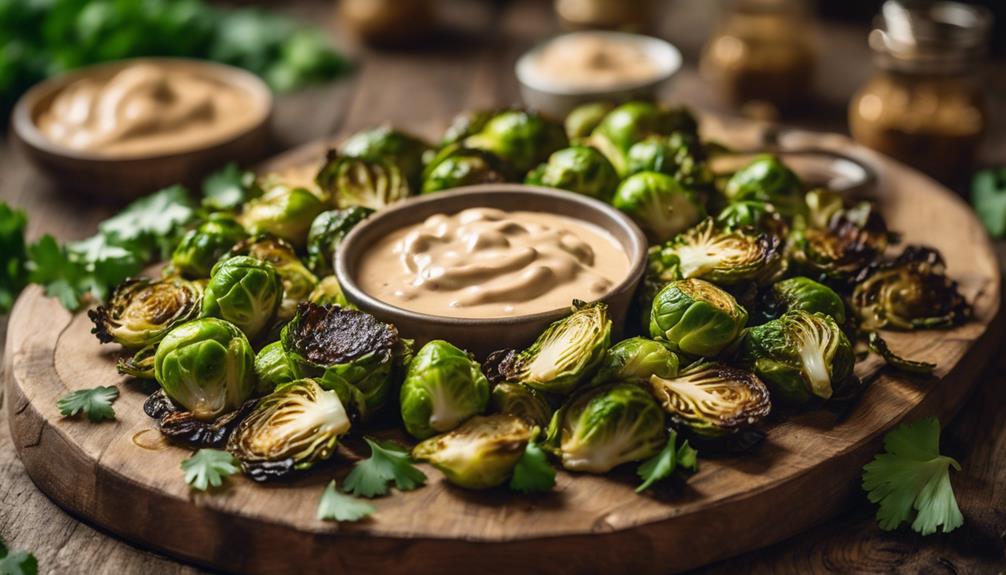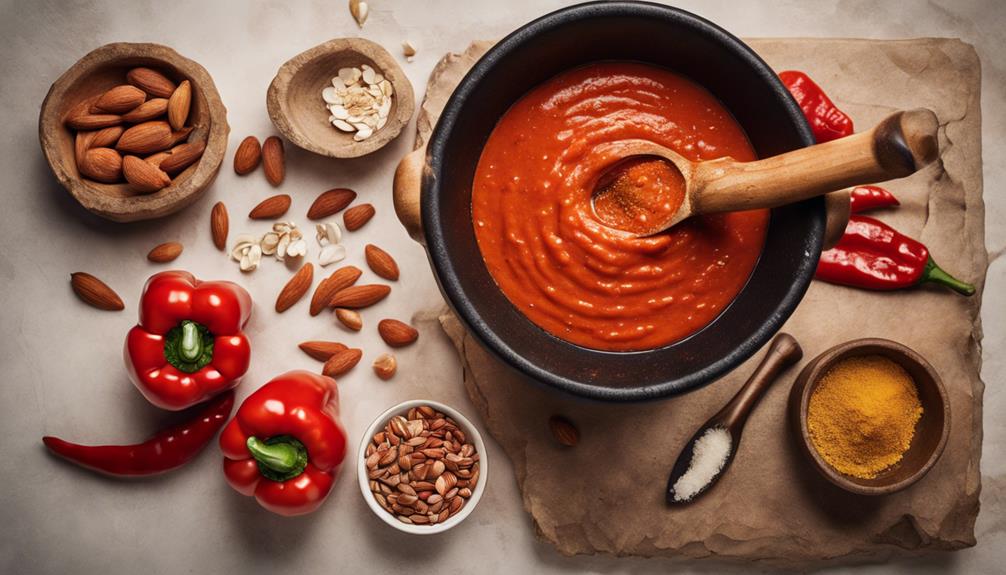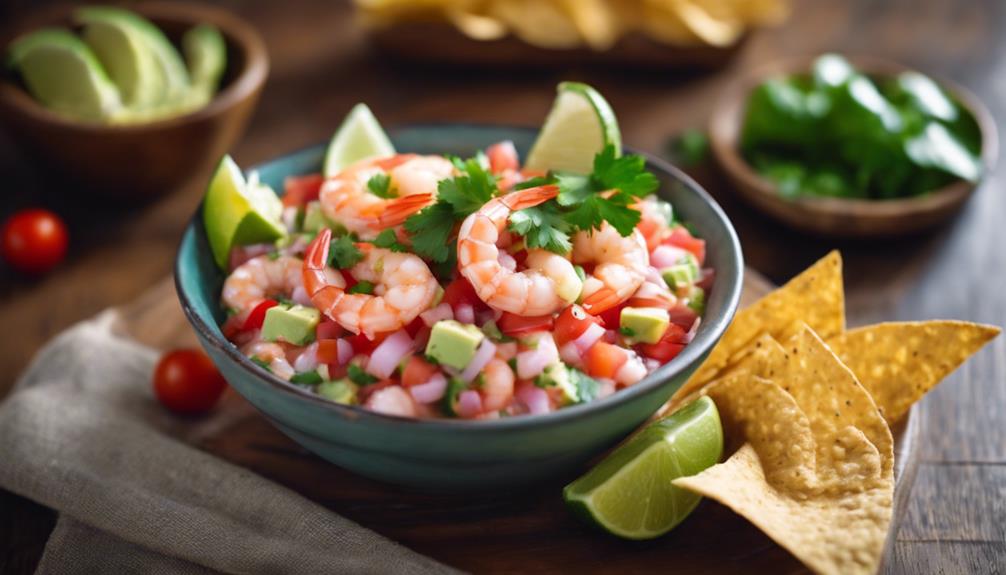Elevate your appetizer game by combining rich and creamy goat cheese with a sweet fig spread. By blending goat cheese with cream, you will create a luxurious base that is perfectly balanced by the sweetness of honey. Add a crunch of pistachios and cranberries for bursts of texture and flavor. Opt for fresh goat cheese log rounds and high-quality ingredients for the best taste. The fruity notes of fig spread perfectly complement the tangy cheese. To assemble, top a toasted baguette with prosciutto and a drizzle of honey. Serve elegantly with wine for a gourmet experience. Explore more tips and pairings to perfect this sophisticated delight.
Key Takeaways
- Whipped goat cheese offers a light and airy texture.
- Fig spread enhances with sweet, fruity notes.
- Pair with toasted baguette for a crunchy base.
- Drizzle honey for a sweet balance.
- Top with pistachios for added crunch.
Ingredients for Whipped Goat Cheese Appetizer
To prepare the whipped goat cheese appetizer, gather goat cheese, cream cheese, fig jam, honey, and your choice of toppings like pistachios and cranberries.
The star ingredients in this gourmet dish are the creamy goat cheese and the luscious fig jam. The tangy notes of the goat cheese perfectly complement the sweet and rich flavor of the fig jam. These two components create a harmonious blend of flavors that's both sophisticated and delicious.
As you combine the goat cheese and cream cheese, the addition of honey brings a touch of sweetness that balances out the tanginess of the goat cheese. The whipped texture achieved by blending these ingredients together results in a luxurious and creamy base for the appetizer.
Toppings like chopped pistachios and dried cranberries not only add a delightful crunch but also introduce bursts of flavor with each bite. When paired with warm crostinis, crackers, or even fresh fruit slices, this whipped goat cheese appetizer becomes a versatile and elegant addition to any gathering.
Selecting the Perfect Goat Cheese

When selecting the perfect goat cheese for your whipped goat cheese appetizer, prioritize choosing fresh goat cheese for its creamy texture and tangy flavor. Opt for a goat cheese log sliced into rounds for easy assembly and serving. Look for high-quality goat cheese from reputable sources for the best taste and consistency. Consider different types of goat cheese, such as plain or herbed, to customize the flavor profile of the whipped goat cheese. Goat cheese pairs exceptionally well with fig spread, creating a delicious sweet and savory combination for the appetizer.
| Goat Cheese Selection | Description |
|---|---|
| Fresh Goat Cheese | Creamy texture, tangy flavor |
| Goat Cheese Log | Sliced rounds for easy serving |
| High-Quality Source | Ensures the best taste and consistency |
| Variety Options | Choose plain or herbed goat cheese for customized flavor |
Fig Spread: A Sweet Addition

Adding fig spread to the whipped goat cheese appetizer elevates the flavor profile with its sweet and fruity notes. The fig spread provides a delightful contrast to the tangy goat cheese, creating a harmonious blend of flavors that enhance the overall taste experience.
The sweetness of the fig spread complements the creamy texture of the whipped goat cheese, resulting in a balanced and sophisticated appetizer that's sure to impress your guests.
Beyond just this appetizer, fig spread is a versatile ingredient that can be used in various recipes to add a touch of gourmet flair. Its unique combination of sweetness and fruitiness makes it a popular choice for pairing with goat cheese due to the complementary flavors they offer.
Whipping the Goat Cheese
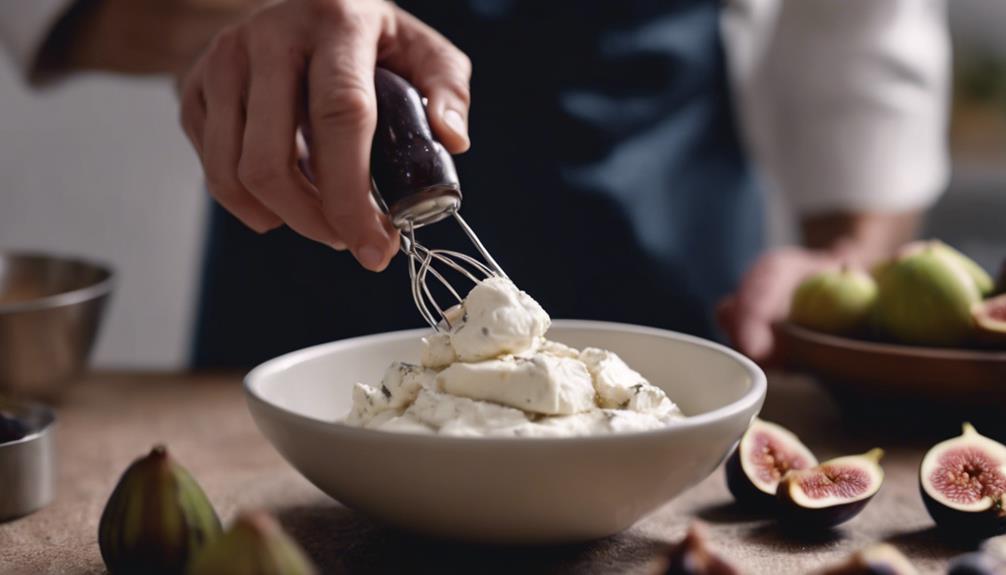
Whipping the goat cheese transforms its texture into a light and airy consistency, ideal for spreading on crostini. This process involves blending goat cheese with cream to achieve a smooth and creamy texture that enhances the richness of the cheese. Adding cream helps create a luxurious mouthfeel that makes spreading the whipped goat cheese effortless. In addition, whipping goat cheese allows for the incorporation of additional flavors like honey, herbs, or spices, enhancing the overall taste profile of the dish.
To visualize the transformation of goat cheese when whipped, consider the following table:
| Texture Before Whipping | Texture After Whipping | Flavor Before Whipping | Flavor After Whipping |
|---|---|---|---|
| Dense and crumbly | Light and airy | Mild | Creamy and rich |
| Firm | Smooth | Plain | Enhanced with herbs/spices |
| Challenging to spread | Easy to spread | Savory | Versatile with added flavors |
Whipping goat cheese not only alters its physical characteristics but also elevates its taste, making it a versatile and delectable ingredient for gourmet appetizers.
Assembling the Gourmet Appetizer

To assemble the gourmet appetizer, gather the ingredients needed such as the whipped goat cheese, fig spread, toasted baguette slices, and crispy prosciutto.
Follow the preparation steps meticulously, layering the whipped goat cheese and fig spread onto the toasted baguette slices and topping them with the crispy prosciutto.
Consider serving suggestions like adding a drizzle of honey or a sprinkle of fresh herbs to enhance the flavors further.
Ingredients Needed
What ingredients are required to assemble the gourmet appetizer of whipped goat cheese with fig spread? To create this delectable dish, you'll need the following:
- Goat Cheese: Provides a creamy and tangy base for the appetizer.
- Fig Jam: Adds a sweet and fruity flavor that complements the goat cheese perfectly.
- Honey: Introduces a touch of sweetness to balance the savory elements.
- Red Pepper Flakes: Offers a subtle hint of spice to elevate the flavor profile.
These ingredients work harmoniously to deliver a blend of creamy, sweet, and spicy notes in each bite. Additionally, the chopped pistachios, dried cranberries, fresh thyme, and French baguette further enhance the texture and taste experience, creating a visually appealing and flavorful appetizer that's ideal for entertaining guests or enjoying as a special treat.
Preparation Steps
How can you best prepare the components to assemble the gourmet appetizer of whipped goat cheese with fig spread?
To begin, toast the baguette slices diagonally and brush lightly with olive oil before toasting in the oven until golden brown.
Meanwhile, lay out the prosciutto on a baking sheet and bake until crispy, adding a delightful texture and flavor to the appetizer.
For the whipped goat cheese, it's advisable to make it a few days in advance, allowing it to come to room temperature before using it in the assembly process.
When assembling the appetizer, it's important to avoid doing so too early to prevent the bread from becoming soggy and to maintain its desired crispiness.
Additionally, if preferred, fresh prosciutto can be used instead of crispy to add a different texture to the appetizer.
Serving Suggestions
For assembling the gourmet appetizer, start by spreading whipped goat cheese on toasted baguette slices. Top each crostini with a dollop of fig spread to create a delightful sweet and savory contrast. Enhance the flavor and texture by drizzling a touch of honey over the fig spread and sprinkling some chopped pistachios on top. These additions will provide a luxurious and indulgent experience for your taste buds.
To present the gourmet appetizer elegantly, arrange the assembled crostini on a platter adorned with fresh thyme leaves. This garnish not only adds a pop of color but also infuses a subtle herbaceous note to the dish.
The combination of creamy goat cheese, rich fig spread, honey, and crunchy pistachios creates a sophisticated flavor profile that's sure to impress your guests. Enjoy the harmonious blend of flavors and textures in each bite of this gourmet appetizer.
Drizzling Honey and Chopping Pistachios

To enhance the flavor and texture of the whipped goat cheese, consider drizzling honey and chopping pistachios.
Honey adds a touch of sweetness that complements the creamy goat cheese, creating a perfect balance of sweet and savory elements in the dish. The drizzle of honey not only enhances the flavor profile but also elevates the visual appeal of the appetizer.
Chopped pistachios, on the other hand, provide a crunchy texture and a nutty flavor that beautifully complements the creaminess of the goat cheese. They not only add a delicious crunch but also bring a pop of color to the dish, making it visually appealing.
The combination of honey and pistachios creates a delightful sensory experience, adding depth to each bite. So, don't forget to drizzle a generous amount of honey and sprinkle finely chopped pistachios over the whipped goat cheese for a gourmet touch that will impress your guests.
Serving Suggestions and Pairings
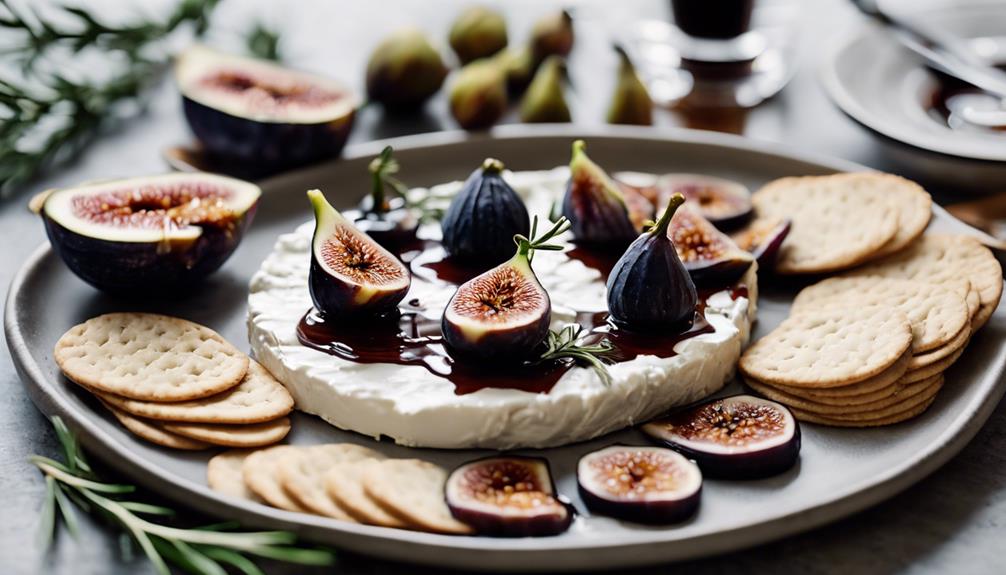
Consider pairing the whipped goat cheese with fig spread with toasted baguette slices for a delightful combination that will please your taste buds.
To elevate this appetizer further, incorporate prosciutto or crispy bacon to enhance the flavors.
For an elegant presentation, serve the whipped goat cheese and fig spread on crostini, adding a touch of sophistication to your table.
This versatile dish pairs excellently with a variety of wines, such as Sauvignon Blanc or Pinot Noir, allowing you to customize your dining experience to suit your preferences.
Enjoy the creamy texture of goat cheese harmonizing with the sweet and rich taste of fig spread, creating a culinary sensation that's sure to impress your guests.
Tips for Storing and Preparing Ahead
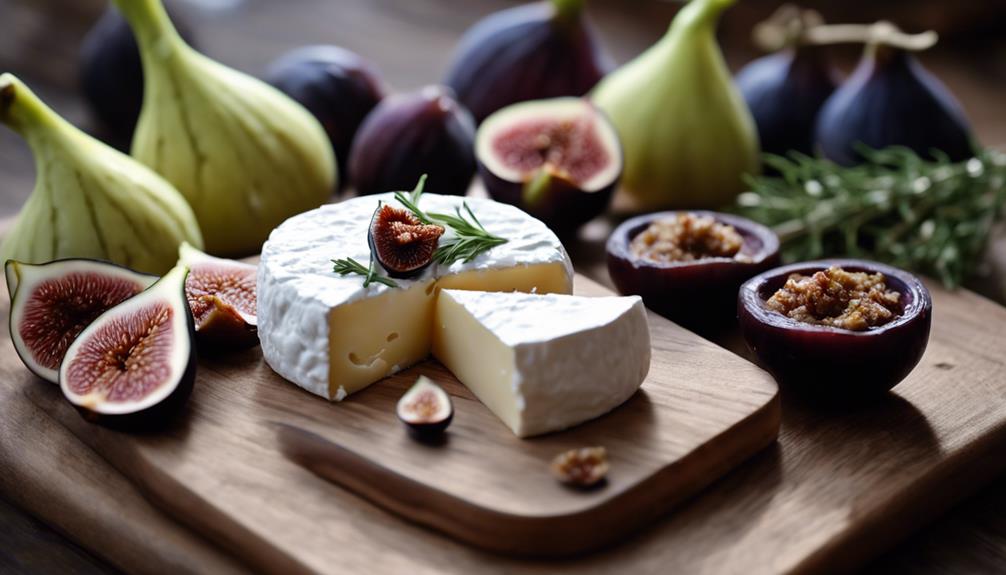
Make sure the whipped goat cheese is stored in the refrigerator for a few days prior to use, allowing it to reach room temperature before serving. This step guarantees that the goat cheese maintains its creamy texture and best flavor when served.
Additionally, you can prepare baguette slices and prosciutto in advance by toasting them, saving you time when assembling the crostini. However, be cautious not to assemble the crostini too early to prevent them from becoming soggy.
If you prefer a different twist, fresh prosciutto can be used instead of crispy prosciutto in the recipe. Moreover, for a unique flavor profile, consider substituting bacon for prosciutto in the crostini.
Frequently Asked Questions
What Do You Eat Goat Cheese Spread With?
You eat goat cheese spread with a variety of accompaniments like crackers, sliced baguette, or fresh fruit. It pairs well with sweet spreads like fig jam or honey, enhancing its tangy and creamy flavors.
What Cheese Is Best With Fig Spread?
For pairing with fig spread, goat cheese stands out as the best choice. Its tangy and creamy nature perfectly complements the sweetness of the fig spread, creating a harmonious blend of flavors in each bite.
What Can I Use Fig Spread For?
So, you're wondering what to do with fig spread? Well, get ready to elevate your culinary game! Use it to jazz up your crostinis, sandwiches, or cheese boards. The possibilities are endless!
What Jam Is Best With Goat Cheese?
For the best pairing with goat cheese, try raspberry, apricot, or cherry jams. Experimenting with different flavors can add a variety of tastes to your whipped goat cheese appetizer, creating a delightful and unique experience.
Can Pigs in a Blanket be Considered Gourmet Like Whipped Goat Cheese With Fig Spread?
When it comes to party favorites, pigs in a blanket are a classic choice. But can they be considered gourmet like whipped goat cheese with fig spread? While they may not have the same fancy appeal, these bite-sized sausages wrapped in pastry are always a hit at any gathering. Their simplicity and universal appeal make them a versatile option for both casual get-togethers and elegant cocktail parties. With the right tweaks to a classic pigs in a blanket recipe, such as using puff pastry and sprinkling gourmet toppings like sesame seeds or truffle salt, they can be elevated to suit a more refined palate. Whether served with creative dipping sauces or paired with a charcuterie board, they remain a crowd-pleaser that’s hard to resist. Additionally, experimenting with international flavors like adding a touch of spice from harissa or a drizzle of honey mustard can give this classic appetizer a modern twist. A well-executed pigs in a blanket recipe can seamlessly blend comfort food nostalgia with upscale sophistication, making it a standout even among more elaborate hors d’oeuvres. No matter how they’re prepared, they offer endless opportunities for creativity while staying true to their crowd-pleasing roots.
Conclusion
To sum up, the whipped goat cheese with fig spread appetizer is a delectable and sophisticated choice for any gathering. With the perfect balance of sweet and savory flavors, this gourmet dish is sure to impress your guests.
By following the simple steps outlined in this article, you can easily create a high-end appetizer that will elevate any event.
So go ahead, indulge in this culinary delight and savor every bite!




